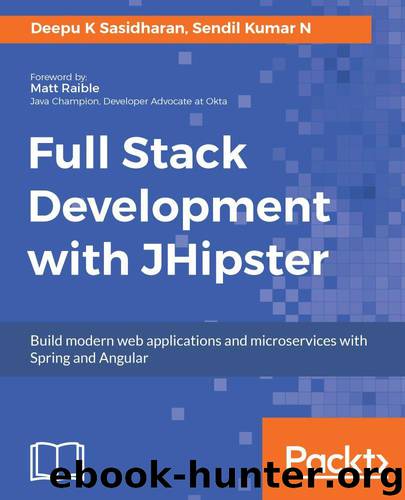Full Stack Development with JHipster: Build modern web applications and microservices with Spring and Angular by Sasidharan Deepu K & N Sendil Kumar

Author:Sasidharan, Deepu K & N, Sendil Kumar [Sasidharan, Deepu K]
Language: eng
Format: azw3
Tags: COM060160 - COMPUTERS / Web / Web Programming, COM051260 - COMPUTERS / Programming Languages / JavaScript, COM051280 - COMPUTERS / Programming Languages / Java
Publisher: Packt Publishing
Published: 2018-03-22T16:00:00+00:00
Setting up Jenkins
Let's use Jenkins as the CI tool for our application. We first need to set up a local Jenkins instance:
If you are already familiar with Docker, you can use the official Docker image provided by Jenkins and can skip the following steps. The Docker image will be automatically generated by JHipster when creating the CD/CI pipeline in the following section. Visit http://www.jhipster.tech/setting-up-ci-jenkins2/ for more details.
Let's download the latest binary from http://mirrors.jenkins.io/war-stable/latest/jenkins.war.
Now open a terminal and navigate to the folder where the file was downloaded.
Execute java -jar jenkins.war --httpPort=8989 from the terminal to start a Jenkins server. The port should not conflict with our application port. The default password will be printed on the console. Make a copy of it.
Navigate to https://localhost:8989 and paste the password copied before.
Click on the Install suggested plugins button on the next page and wait for the plugin installation to complete.
Create an admin user on the next page and complete.
Download
This site does not store any files on its server. We only index and link to content provided by other sites. Please contact the content providers to delete copyright contents if any and email us, we'll remove relevant links or contents immediately.
The Mikado Method by Ola Ellnestam Daniel Brolund(20603)
Hello! Python by Anthony Briggs(19899)
Secrets of the JavaScript Ninja by John Resig Bear Bibeault(18208)
Dependency Injection in .NET by Mark Seemann(18108)
The Well-Grounded Java Developer by Benjamin J. Evans Martijn Verburg(17575)
Kotlin in Action by Dmitry Jemerov(17183)
Sass and Compass in Action by Wynn Netherland Nathan Weizenbaum Chris Eppstein Brandon Mathis(13265)
Secrets of the JavaScript Ninja by John Resig & Bear Bibeault(11381)
Jquery UI in Action : Master the concepts Of Jquery UI: A Step By Step Approach by ANMOL GOYAL(9386)
Svelte with Test-Driven Development by Daniel Irvine(8139)
Test-Driven Development with PHP 8 by Rainier Sarabia(7888)
Layered Design for Ruby on Rails Applications by Dementyev Vladimir;(7707)
Web Development with Django by Ben Shaw Saurabh Badhwar(7216)
React Application Architecture for Production by Alan Alickovic(6899)
Software Architecture for Web Developers by Mihaela Roxana Ghidersa(4980)
Audition by Ryu Murakami(4888)
Accelerating Server-Side Development with Fastify by Manuel Spigolon Maksim Sinik & Matteo Collina(4837)
Solidity Programming Essentials by Ritesh Modi(4565)
Build Your Own Web Framework in Elixir by Aditya Iyengar(4439)
